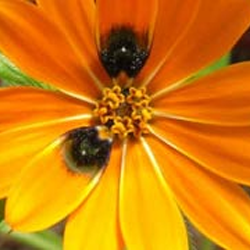
The amazing diversity of flowers is a biological mystery that has long intrigued scientists. Dr Beverley Glover explains how new understanding of petals and pollinators is helping to solve the puzzle.
The amazing diversity of flowers is a biological mystery that has long intrigued scientists. Dr Beverley Glover explains how new understanding of petals and pollinators is helping to solve the puzzle.
Our laboratory in the Department of Plant Sciences is using a combination of developmental biology, evolutionary biology and studies of bumblebee behaviour to understand how and why there are so many sorts of flower.
Dr Beverley Glover
Flowers only appeared on Earth 130 million years ago, much later than most other major groups of organisms, which appeared closer to 500 million years ago. And yet, flowering plants are one of the most species-rich groups on Earth – second only to arthropod animals such as insects, spiders and crustaceans. How and why did this group of plants produce so many different species so quickly? Charles Darwin himself described the problem as an ‘abominable mystery’, and it has fascinated scientists ever since.
The answer is in the petals
There are lots of theories as to why flowering plants diversified so quickly, but most scientists point to the link between flowers and insect pollinators as the primary cause. Many of the different insects that carry pollen from one flower to another vary in their size, shape, mouthpart structure, colour vision, sense of smell, taste, ability to grip the flower, and a host of other traits. As flowers evolved to become dependent on pollinators for reproduction, so they also started to acquire a whole range of flower forms that were attractive to subsets of all of these different animals.
Our laboratory in the Department of Plant Sciences is using a combination of developmental biology, evolutionary biology and studies of bumblebee behaviour to understand how and why there are so many sorts of flower. We investigate the genes controlling individual flower morphologies and explore their evolutionary history in related plants, and we search for the DNA changes that lead to new flower types and determine how pollinators respond to these different flower forms.
Spotting daisies
The team has recently begun a large-scale analysis of all of the genes that are active in the insect-mimicking spots of a South African daisy, thanks to funding under the SynTax scheme from the Biotechnology and Biological Sciences Research Council (BBSRC) and the Natural Environment Research Council (NERC). Gorteria diffusa has wonderful orange flowers; on some of the ray florets (the white petal-like structures on British daisies) appear raised black spots, which mimic the fly that pollinates the plant. Without the black spots, the flies don’t visit the flowers and the flowers don’t set seed. Once we have identified which genes are essential for petal spot development, the goal is to explore their function in a range of related daisies with similar spots – or more spots, or no spots – to understand spot evolution.
The power of flowers
Not all of the lab’s work is focused on how flowers gain new features. One project, for instance, looks at how and why some flowers of the Solanum genus (which includes species such as tomatoes, potatoes and many garden varieties) have lost a particular type of cell on the surface of their petals.
A cell type commonly found at the surface of petals in flowering plants has a distinctive conical shape that we discovered is very important to help bees grip flowers when they land on the petal. Despite this function, such cells seem to be disappearing from Solanum, with several species in the genus showing independent reversion to a smooth flat petal.
 It seems very likely that this too is to do with pollination. Flowers in this genus are pollinated by what is known as buzz pollination. A bee that is buzz pollinating is one that is searching for pollen, rather than nectar, which it needs to feed the developing larvae back in the hive. Instead of landing on the petal, the bees hold onto the anthers of the flowers and vibrate their wing muscles, causing the pollen to fly out of the pores at the anther tips and land on the bee’s body. To be best-suited to this type of bee behaviour, it would be advantageous to the flower to have slippery petals, forcing the bee to grab hold of the anthers.
It seems very likely that this too is to do with pollination. Flowers in this genus are pollinated by what is known as buzz pollination. A bee that is buzz pollinating is one that is searching for pollen, rather than nectar, which it needs to feed the developing larvae back in the hive. Instead of landing on the petal, the bees hold onto the anthers of the flowers and vibrate their wing muscles, causing the pollen to fly out of the pores at the anther tips and land on the bee’s body. To be best-suited to this type of bee behaviour, it would be advantageous to the flower to have slippery petals, forcing the bee to grab hold of the anthers.
To test these ideas, the lab is using transgenic approaches to generate Solanum species with conical petal cells – essentially re-building the missing flower morphology – to examine how petal cell shape affects bumblebee behaviour in this unusual pollination system. At the same time, other members of the team are working to identify the genes that normally produce conical petal cells, to understand why they don’t function in Solanum.
All the colours of the rainbow
Flower colour, too, might be more complicated than it seems. The surface of some tulip petals, for instance, is covered in very fine lines, or striations, of a waxy material called cuticle. These striations are at a similar frequency and amplitude to those of a compact disk and, in just the same way, they are able to diffract light into different wavelengths and reflect these wavelengths at different angles, generating iridescence. The iridescence is usually quite hard to see, because it’s primarily at the ultraviolet (UV) end of the spectrum, however this is the end where insects see well.
We know that this iridescence is visible to bees and are now working out how it might affect the ability of pollinators both to recognise different flowers and to identify flowers over greater distances. Now, thanks to funding from the Leverhulme Trust, and in collaboration with colleagues at Kew Gardens and Professor Ulli Steiner in the Department of Physics’s Cavendish Laboratory in Cambridge, we have begun to explore just how common UV-based iridescence is in flowers and how many different ways plants have evolved to generate it.
Planting the seeds to protect our crops
At the heart of our work is the common theme of understanding the links between flowers and the animals that pollinate them. These links are increasingly important in agriculture since around one third of food comes directly from insect-pollinated crops such as apples, tomatoes, broad beans and rapeseed oil. The decline of pollinator populations has been widely reported in the press and, although wild pollinators might not be suffering quite as much as commercially managed ones, nobody knows quite how climate change might influence pollinators and their relationships with plants in the future. Exploring these complex networks in detail should provide us with the information to devise strategies to protect crop pollination, as well as protecting natural plant-pollinator biodiversity, in the years to come.
For more information, please contact Dr Beverley Glover (bjg26@cam.ac.uk) at the Department of Plant Sciences.
This work is licensed under a Creative Commons Licence. If you use this content on your site please link back to this page.





